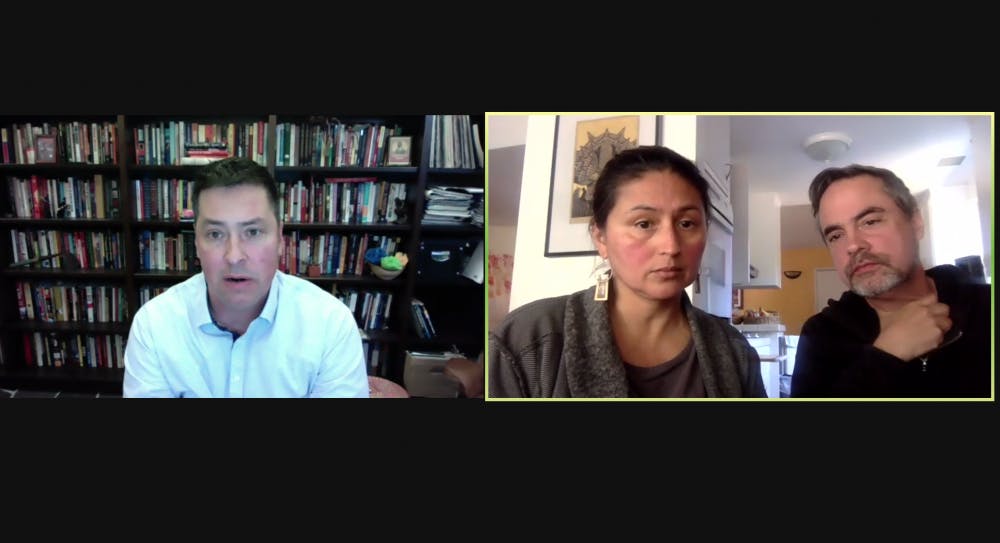In 2012, activists with the National Immigrant Youth Alliance purposefully got arrested by the United States Border Patrol. They had planned to infiltrate the Broward Transitional Center in Florida and reveal the inner workings of the immigration system. “The Infiltrators,” a film by Alex Rivera and Cristina Ibarra, details the NIYA’s efforts.
The Center for the Study of Race and Ethnicity in America invited Rivera and Ibarra to talk about this 2019 Sundance award-winning docu-thriller during a live webinar held March 1. The event, titled “The Infiltrators: A Conversation with Filmmakers Alex Rivera and Cristina Ibarra,” focused on their filming process and exchanges with the young activists behind the scenes.
The documentary follows Marco and Viri, two activists who in 2012 infiltrated the Broward Transitional Center, which houses non-criminal, low-security individuals suspected of residing in the US illegally, as part of a mission to end deportations.
The conversation was moderated by Stephen Pitti, director of the Center for the Study of Race and Indigeneity and Transnational Migration and professor of history and American studies at Yale, with opening remarks from Stéphanie Larrieux, associate director of the CSREA at Brown.
According to Rivera, immigrant stories have been a central part of recent public debate. “For the past 25 years, it’s been fascinating watching these fault lines in our national discourse around the contours of the nation,” he said. It is a persistent question of “who is in, who is out, what place do people belong in inside of power?”
The Mexican-American border took center stage in the immigrant stories that the two filmmakers wanted to tell, Ibarra said. The border and representation of immigrants “was something that we were thinking about often,” she said. “That’s really how we came across what the activists (in the documentary) were doing.”
Rivera said he and Ibarra met the young activists from NIYA just as they had begun to “perform acts of radical civil disobedience.” The activists, who are known as “the infiltrators” in the documentary, were “saying with their bodies that they were done waiting for change” to the Obama administration’s immigration policies. “It was revolutionary,” Rivera said.
When these young activists decided to infiltrate the detention center, Ibarra and Rivera decided to make the act of resistance the focus of their next documentary. In creating the film, they blended documentary footage, dramatizations of the detention center, footage from the U.S. Department of Defense and voice-overs.
While the film is now considered to be a docu-thriller by the filmmakers, this was not their original intention. “It started off as a normal documentary … but then the story was unfolding behind the walls of the detention center and we as documentarians were outside,” Rivera said.
As they worked on the film, Rivera and Ibarra realized that they could blend the lines between documentary and thriller by incorporating traditional forms of documentary filmmaking with acted scenes.
In order to facilitate this hybrid style, Ibarra and Rivera held workshops in New York with the actors and activists to work in a collaborative effort and depict the infiltration truthfully and respectfully.
While this hybrid nature of combining documentary footage with acting allowed for deeper context into the workings of the infiltration, Ibarra and Rivera remarked that it did not go without its challenges.
The film took seven years to create, with most of the filming of the 24 speaking parts done primarily in the last six months. “It was difficult to find the right balance” between including the subjects of the film and portraying them with actors, Ibarra said. “We had to figure out whether (they) wanted to be portrayed as the real person or with an actor, because we had the unintended opportunity to hide people’s identities,” she said.
And while they originally planned to not include experts and authorities beyond the activists and their portrayals by actors, they decided it was important to include the perspective of individuals like Rep. Ted Deutch of Florida to show the “power” of the activists’ work.
Ibarra and Rivera emphasized the importance of staying true to the activists’ descriptions of their time in the detention center to create a realistic portrayal of events. In centering the perspectives of the activists in the documentary, Rivera said the film poses the question of “how can stateless people produce political power outside of voting?”





